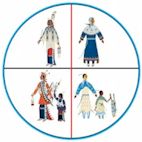![]()
   |
||
|
|
Lesson
Plan #10 - Building an Electric Motor Goals: To enable students to demonstrate the process of science by posing questions, observing, and investigating phenomena through the language, methods, and instruments of science. Culturally Relevant Activity: Hands-on, inquiry-based, and cooperative learning activity. This kind of activity is the most effective style of learning for American Indian students. This kind of activity increases the likelihood that American Indian students will enter careers in Science, Engineering, and mathematics, which will contribute to the technological, economic, and social advancement of American Indians. This activity fosters a connection between classroom and actual applications around the home. This kind of activity will enhance the academic self-esteem of American Indian students and prepare them for a technological society. Instructional Objectives: The student will:
Introduction: Magnetism and electricity have had a great influence on our civilization. They have changed our world. Magnetism is used to generate electricity, which supplies power for our homes, industries, communication, transportation, and many other purposes. Our civilization cannot exist without electricity. In this lesson plan, the students study the characteristics of magnetism and they build and study an electromagnet, which is a magnetic field (magnet) generated by an electric current (electricity). This leads to the last part of the lesson plan, which is building an electric motor. The function of the electric motor is based on the interaction between electricity and magnetism.
How Magnets Interact Materials: Procedure: Suspend
each bar magnet by a string tied around the middle of the bar, and observe
which end aligns with North. Mark that end as N for north and the other
end as S for south. You have determined the poles of each magnet. Put the
two bar magnets on the table with the North Pole of one magnet next
to the North Pole of the other magnet as shown in figure 1. What do
you observe? Discussion: Magnets have North and South poles. The North Pole of a magnet always points north. The law of magnets states that like poles repel each other and unlike poles attract each other. The North Poles of magnets repel each other, as do South Poles. The North and South Poles attract each other.
Building an Electromagnet Materials: A drinking
straw Procedure:
Discussion: When electricity (electric current) flows through a wire, it produces a magnetic field around the wire. If the wire is wound into a coil of several turns, the magnetic field becomes stronger. A coil carrying electricity can do all the things a permanent magnet can do. We call this kind of magnet an electromagnet. Electromagnets are very useful because their magnetism can be turned on and off. An electromagnet looses its magnetism when the electric current in the coil is disconnected. Electromagnets are used in many of our machines. They are used in electric motors and generators. Electric motors run many of our appliances such as refrigerators, dishwashers, vacuum cleaners, blenders, video machines, power drills, etc.
Building an Electric Motor Materials: Procedure:
Discussion: When electricity (electric current) flows through the coil, it creates a magnetic field around the coil. The coil becomes a magnet (electromagnet). The like poles of the coil and the magnet repel each other causing the coil to rotate. Just as the unlike poles of the coil and magnet are about to align, which will cause the coil to stop rotating, the flow of the electricity in the coil is cutoff eliminating the magnetic field of the coil. This happens when the enamel at one end of the wire that makes up the coil comes in contact with the paper clip during rotation. The momentum of the coil allows it to continue to rotate. As the coil rotate, the electricity in the coil is reestablished, which happens when the enamel stripped bottom half of the end of the coil comes in contact with the paper clip. The process continues and the coil keeps rotating. Biography A. Wehbe received his B.S. and M.S. degrees in Electrical Engineering from North Dakota State University at Fargo. Since 1989 he has been teaching Electronics and Mathematics at Fort Peck Community College in Poplar, Montana. Dr. Wehbe recently (summer, 2002) received his Ph.D. degree in Electrical Engineering at the University of North Dakota in Grand Forks. Dr. A. Wehbe is a member of the IEEE Society.
| |

